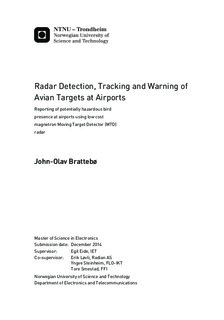Radar Detection, Tracking and Warning of Avian Targets at Airports - Reporting of potentially hazardous bird presence at airports using low cost magnetron Moving Target Detector (MTD) radar
Master thesis
Permanent lenke
http://hdl.handle.net/11250/2471402Utgivelsesdato
2014Metadata
Vis full innførselSamlinger
Sammendrag
During the last years, Radian AS has been working on new methods for improving the detectioncapability of the standard civil marine radar. A coherent-on-receive radar demonstratorwith a PC-based platform has been developed and the methods are found wellsuited for detecting small moving targets over land and sea. An operational birdstrike(aircraft-bird collision) avoidance radar system based on this technology has recently beendeployed at Værnes Airport, Norway. This system uses a slightly modified civil marineradar, a computer and methods of detection based on a Moving Target Detector (MTD)processor. The resulting radar video is broadcast to the airport s Air Traffic Control (ATC)Tower to allow initiation of precautionary measures. Since the current system demandsmanual interpretation and constant monitoring of the MTD radar video, there is need foran Automatic Detection and Tracking (ADT) system and a warning system that draws attentionto specific situations.
In this Master s Thesis, methods for radar detection, tracking and Early Warning (EW)of avian targets at airports are investigated. The work is based on theoretical analysis, testing with real radar measurements and simulation that incorporates real measurements. Themethods of detection are improved by modification of the MTD processor. A specialized,batch-processing tracker called a Bird Flight Path Detector (BFPD) Tracker is developedand implemented to automatically identify and track birds in the airport vicinity. An EWfunctionality is also developed and implemented to monitor the resulting tracking data andgive warning of potentially hazardous situations in advance. Furthermore, the performanceof the proposed tracker and the resulting total system is optimized, analyzed and evaluated.
The detection capability of the radar is found sufficient for use in a birdstrike avoidanceapplication. According to performed theoretical calculations, the existing radar system isable to detect a single goose at about 4 km with a probability of detection of P_d = 0.7 anda probability of false alarm of P_fa = 0.001. Testing shows that in practice, multiple flocks(of varying numbers) of geese are detected consistently enough to allow continuous trackingby the BFPD Tracker up to about 4 km in range over both land and sea. It is also shownthat the BFPD Tracker is be able to identify and follow all of the important bird presencewhile simultaneously exhibiting a probability of true (caused by birds) confirmed trackestablishment around 70% and a probability of true batch association around 96-100%.The latter is hence a good indicator of true bird presence. Simulation experiments showthat the total system is able to detect an avian target roughly the size of a single goose atranges of about 3 km with P_d = 0.875 and P_fa = 0.001. Simulation also shows that theBFPD Tracker is able to track this target continuously up to 4 km over sea with an RMSerror of 2.37 m in range, 0.084 in azimuth and 1.64 m/s in velocity.
The EW functionality is found capable of identifying and giving warning of almost allmanually identified potentially hazardous situations while showing a very low probabilityof false warning (<< 1%). Long-term testing and corresponding knowledge of the truebird activity is needed to accurately estimate the probability of false warning, but thiswork indicates that the BFPD Tracker and EW function is suited for tracking and EWapplication in an ATC Tower. Near real-time processing is deemed feasible with standardcomputing hardware and if the system is developed further it may help mitigate overallbirdstrike risk and contribute to improved safety in aviation.
